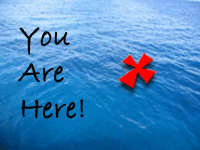 |
Station Information
The majority of CalCOFI field work consists of the occupation of the oceanographic stations -specific geographic locations - which pattern the survey area. Seventy-five stations are scheduled during a typical 18 day cruise. Coverage is expanded north of Pt Conception during winter and spring spawning seasons to 104 stations. Within the allotted ship time, each cruise occupies every station possible but the station plan is dynamic. Stations are reordered or dropped when weather, ship, medical, or naval issues interrupt station operations.
In 1949, the cruise transects were determined by lines drawn on nautical charts perpendicular (true bearing 330 degrees) to the California coastline 40 nautical miles apart. Stations in the coastal regime were spaced every 20nm or closer, around features such as basin or islands. Offshore stations were spaced 40nm apart to create a 40x40nm grid. The main goal was the measurement of onshore-offshore gradients strongly influenced by the California Current & bathymetry. Most oceanographic features off the California coast are influenced by the southward flow of the California Current and a seasonal, northward, near-shore counter current. Having transects oriented at right angles to the coastline allows better resolution of transition zones than if they were along the lines of latitude and longitude. In referring to a station number under the present plan, the line number is given, then a decimal point, then the station number. This scheme facilitates quick identification of the station location within the pattern: station 90.60 is station 60.0 on line 90.0, for example.
Station Operations
Scientific operations on CalCOFI cruises are scheduled 7/24 - around the clock 7 days a week. Scientists, technicians, and volunteers typically work 12hr shifts scheduled from noon to midnight or midnight to noon. In good weather, the ship transits at ~10kts to minimize ship noise in the fisheries acoustics data. Transits between stations 20nm (nautical miles; eg. 93.50 to 93.55) apart take ~2hrs; transits between stations 40nm apart (eg. 93.60 to 93.70) take ~4hrs at 10kts (1 'station unit' = 4nm). But transit times between stations are heavily influenced by sea state. Station time averages ~2.5 hours but vary depending on CTD cast depth & other station activities.
Station Operations Troubleshooting
Shiptime is limited and expensive so keeping station operations, such as CTD-rosette deployment and recovery, running smoothly are critical to maintaining our station schedule. Station operations are organized for efficiency with stationary operations first (CTD, secchi, vertical net tows) then moving operations such as Manta & Bongo net tows. Although efficient use of shiptime is critical to finish all the scheduled stations & work. Safety is the top priority so protocols for prepping gear for station, deck ops, and 'over-the-side' operations change when the weather is rough. CTD-rosette prep, typically done 20mins before station arrival, may wait until station arrival to insure the safety of all participants & equipment. CTD-rosette descent speed may be reduced to 25-30m/min to minimize strain on the conductive wire.
This page outlines some strategies and general practices for maximizing ship/station time safely:
Primary strategy - redundancy: CalCOFI typically carries duplicate hardware for all mission-critical systems. We carry two complete CTD-rosette systems although only one is typically assembled. Most problems usually require the replacement of a defective or failing sensor, cable, or battery. Two complete sets of nets are onboard so unless the ship equipment fails (hydraulics, winches, for example), swapping out faulty gear should cause a minimal delay. At least two of everything: stopwatches, data acquisition workstations, sampling gear, analytical gear, etc will pay for themselves the first time they are needed.
Secondary strategy - continue station work if possible: while addressing a problem, continue with alternate station work. If CTD operations are not working, move on to other station work such as net tows. Net tows take about an hour, so this will allow troubleshooting problems with the CTD-rosette.
